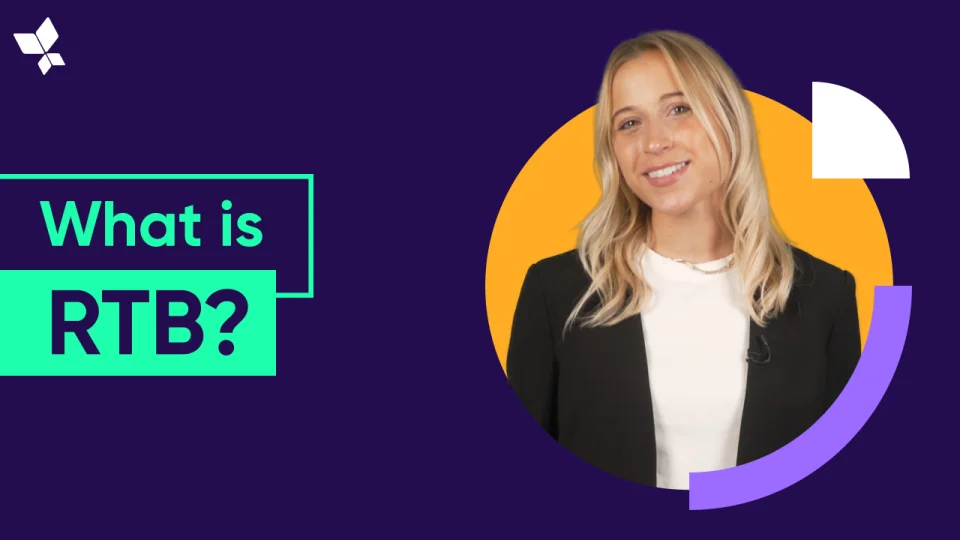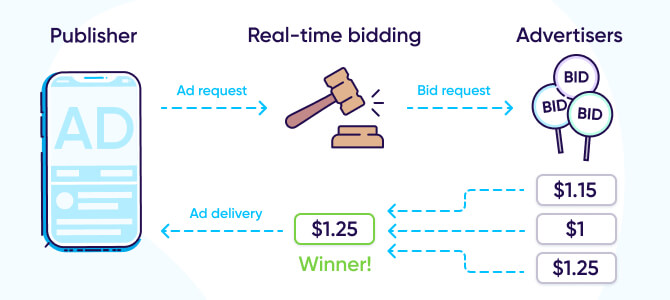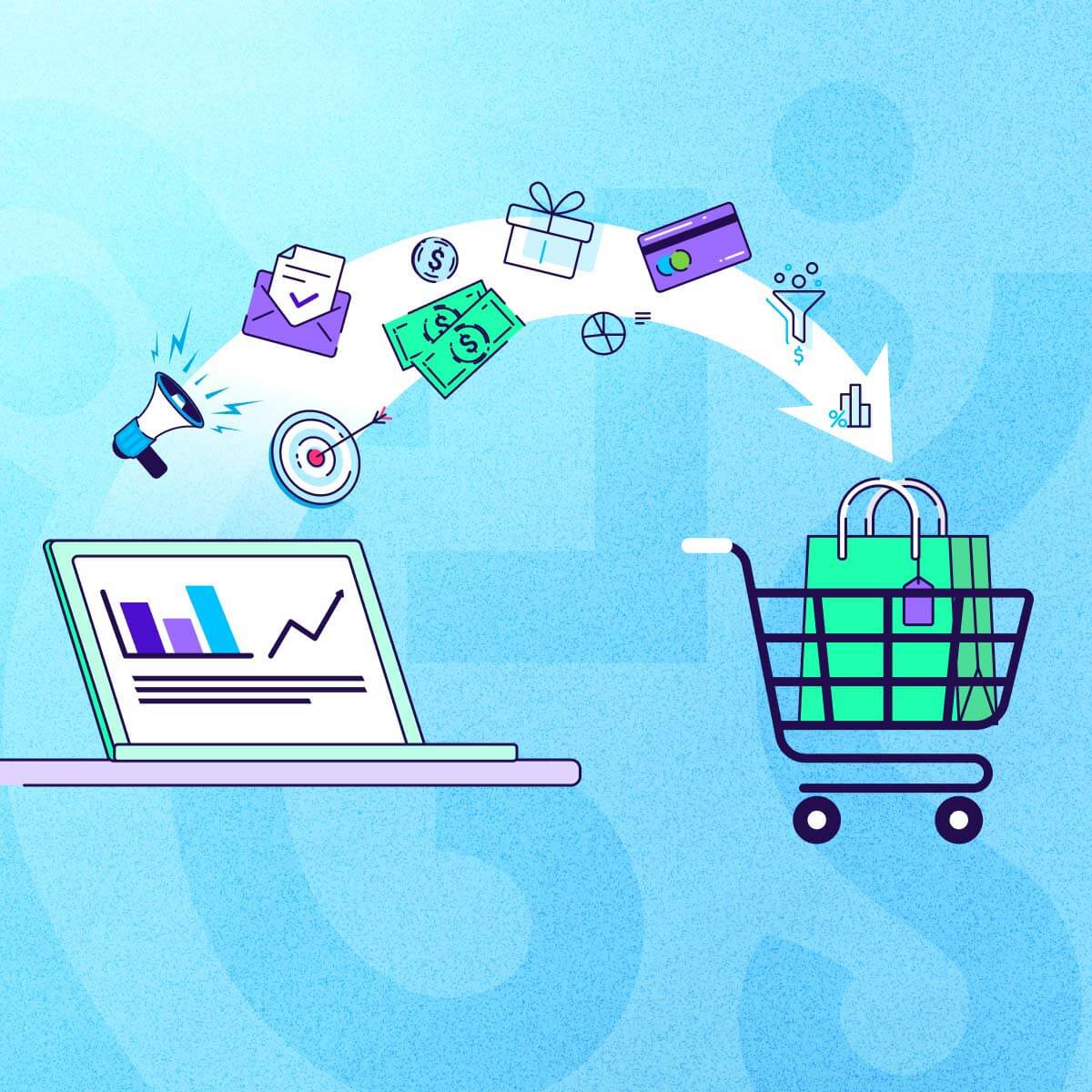In the programmatic advertising world, real-time bidding (RTB) is the process of advertisers bidding automatically for ad impressions auctioned by publishers (websites or apps). The auction is completed in the time it takes for the page to load.
What is real-time bidding (RTB)?
RTB is an integral part of programmatic advertising, which is the buying and selling of digital ad space in real time and on a per-impression basis. It takes the form of an instant auction, facilitated by programmatic technology, where publishers offer their available inventory and advertisers bid on the spots they want in order to reach their audience.
Do you know that moment during a mobile game where you’re served an ad in between game levels? It’s right there that an auction was triggered, and all of the advertisers interested in showing you (the player) an ad bid for the impression. It takes just a split second for the highest bidder to be chosen and their ad to be served to you.
RTB is a highly efficient process, helping advertisers to reach their ideal audience and publishers to maximize revenue from their digital real estate.
RTB vs programmatic advertising
It’s easy to mix up RTB and programmatic advertising. While programmatic advertising encompasses the whole digital ecosystem that enables ads to be bought and sold in real time, RTB is just one piece of the puzzle, covering the milliseconds where the bidding happens.
To confuse matters further, programmatic advertising can take place without RTB. That’s because not all campaigns use this type of open bidding strategy: alternative methods include a private marketplace or a programmatic guaranteed deal, where advertisers and publishers negotiate one on one.
How does real-time bidding work?
With RTB, multiple advertisers bid on a single impression of a publisher’s inventory in real time, and then the highest bid (the winning ad) is shown to the user.
To understand how this works in practice, we first need to recognize the key players in the programmatic field:
- Advertiser: On the “buy side”, the advertiser is the company promoting its product or service. They’ve developed the creative and want to get it in front of their ideal customer.
- Demand-side platform (DSP): A DSP is the technology that enables advertisers to bid automatically for available ad space. DSPs communicate with the supply side to find out what inventory is available and at what price. They also analyze user data and multiple other factors to identify which impressions to bid on.
- Publisher: On the “sell side”, publishers are the websites and apps with ad inventory to sell. They sell each spot to the highest bidder to maximize revenue.
- Supply-side platform (SSP): An SSP is the technology that enables publishers to auction their available ad space. SSPs can sort bids by advertiser, format, audience, and price, ensuring the best possible match for the publisher.
- Ad network: These act as an intermediary between advertisers and publishers. They gather inventory from publishers and buy it in bulk, before selling on relevant impressions to advertisers. Ad networks can also be used by advertisers to manage their campaigns.
- Ad exchange: Think of an ad exchange like a digital trading floor, where the deal is done in real time.
As soon as a user lands on a web or app page, the SSP sends a bid request to the ad exchange, advising that inventory is available. The bid request includes user data (depending on what they’ve consented to share) as well as publisher requirements (like ad format, number of impressions, and price).
The ad exchange then opens up an auction to advertisers. DSPs automatically (and instantaneously) analyze the bid request, and decide whether to bid and how much.
The space is sold to the highest bidder, making the most popular placements highly competitive. As soon as the deal is done, the ad is displayed to the user — so seamlessly that they would never guess what was going on in the background!
What are the pros and cons of real-time bidding?
Programmatic advertising has revolutionized the buying and selling of digital ad space, enabling ever-greater personalization and efficiency. It’s estimated that by 2026, the market will be worth 725 billion US dollars — and RTB will play a big part in that. But nothing’s perfect, so let’s take a look at some of the pros and cons.
Pros of RTB
Both advertisers and publishers value the efficiency of RTB: it’s streamlined their processes and boosted their bottom lines, with better returns and less wastage. Let’s look at some further advantages:
- Precise audience targeting: With RTB, advertisers bid on ad space meant for a specific audience. This targeting allows advertisers to reach the exact customers who want what they offer, yielding better conversion rates. That’s why, when you’re reading your favorite clean eating blog, you might see ads for your local health food store.
- Financial control: RTB opens up ad inventory to a wide pool of buyers, and the “highest bidder” model drives competition, maximizing revenue for publishers. What’s more, publishers can set a floor price for their inventory to be sure they don’t lose out. Likewise, advertisers can set a maximum bid to keep a lid on costs.
- Real-time optimization: Because RTB takes place in the moment, both advertisers and publishers can quickly tweak their strategies for improved results. Advertisers can adjust bidding and targeting, while publishers can identify the most in-demand spots and charge accordingly.
Cons of RTB
While programmatic advertising and RTB are the future of digital advertising, there are some drawbacks — notably the lack of human control:
Lack of control over context: Because the human piece has been removed from programmatic advertising, there is potential for ad match mistakes that can leave an advertiser looking bad.
Imagine you’re reading the news on your phone, and there’s a story about a devastating plane crash. Below the article is an ad for a travel site running a special on plane tickets — kind of insensitive, right? Relying only on algorithms, keywords, and RTB to place ads can sometimes backfire on advertisers.
- Lack of control over content: On the other hand, for publishers, selling your precious impressions programmatically means that you give up control over who and what appears on your page. What if you’re a vegan food company and an ad for leather handbags pops up? Will users question your integrity or avoid your site in the future?
Data challenges: RTB relies on publishers understanding their users, and that’s becoming more challenging. With users opting out of iOS tracking, and the cookieless future looming, accurate user data is harder to come by. Publishers must also be careful to comply with the data protection rules that apply to their audience, such as GDPR or CCPA.
Header bidding, also known as advanced bidding or pre-bidding, is a programmatic approach to selling advertising space in real time. It’s a subset of RTB, where publishers auction inventory to multiple ad exchanges that bid for the highest price.
This might sound pretty similar to RTB, but there are subtle differences. Whereas traditional real-time bidding has each ad exchange performing its own auction one at a time, header bidding allows all of the ad exchanges to bid on multiple auctions simultaneously, using RTB.
Header bidding is like the 2.0 version of programmatic ad buying, with benefits for audience and reach. By offering their inventory to multiple ad exchanges, publishers gain exposure to more advertisers — leading to higher yields on premium space, improved fill rates, and, ultimately, increased revenue.
Real-time bidding vs. programmatic buying
Programmatic buying is the non-auction model in programmatic advertising. Rather than using a bidding process, publishers sell their ad space directly to advertisers for a negotiated price and for a fixed amount of time.
Due to the higher costs of programmatic buying, it’s more common at the premium end of the market, where advertisers want to know exactly who is seeing their ad, where, and in what context.
RTB platform examples
We’ve covered the what, how, and why of RTB — but where does it actually happen? Aside from the giants like Google Ads and Amazon Ads, there are numerous other platforms that may be less familiar. For example:
Platforms for advertisers (DSPs):
- theTradeDesk
- AdRoll
- mediasmart
Platforms for publishers (SSPs):
- Outbrain
- OpenX
- Magnite
- Smaato
- Index Exchange
Mobile RTB
As the smartphone market continues to grow, marketers are taking an increasingly mobile-first approach, while in-app advertising has become crucial for app developers looking to monetize. Mobile RTB lets advertisers bid for space on mobile sites or apps.
Whereas web publishers can offer header bidding (discussed earlier) to maximize revenue, the app equivalent is in-app bidding. This enables app publishers to get the most competitive rates for their ad space, while showing relevant ads to users.
The future of RTB: trends to watch
The efficiency, control, and flexibility of RTB mean it’s here to stay. In fact, research shows that by 2030, the global RTB market could be worth an impressive £19.7 billion US dollars, driven up by rising smartphone penetration. But what else might lie ahead?
Privacy challenges
RTB has traditionally relied on cookies to gather and analyze user data for targeting. Facing a cookieless future, publishers will need to look for alternative solutions, such as privacy-preserving aggregated data.
AI and machine learning
Artificial intelligence can be used to analyze large volumes of data, enabling both advertisers and publishers to optimize campaigns. This could enable better contextualization, preventing the unfortunate ad placements mentioned earlier. Plus, by analyzing user behavior, these tools can also pick up on things that don’t look right, helping to combat fraud.
Connected TV (CTV)
RTB is becoming increasingly popular for advertising on CTV (any device that streams content over the internet), enabling high-precision targeting of an engaged audience.
Frequently asked questions
What is real-time bidding (RTB)?
Real-time bidding is a fundamental component of programmatic advertising, enabling the automatic buying and selling of digital ad space in real-time on a per-impression basis. It involves an instant auction, where advertisers bid for ad space offered by publishers to target their desired audience.
Real-time bidding involves multiple advertisers bidding on a publisher’s ad inventory in real time. Publishers offer ad space through an SSP (supply-side platform), and advertisers automatically bid on relevant spots through a DSP (demand-side platform). This all takes place as soon as a user lands on the page, and the highest bidder’s ad is displayed in real-time.
What are the advantages and disadvantages of RTB?
Pros of real-time bidding include precise audience targeting, financial control, and real-time optimization for advertisers and publishers. Cons involve potential mismatches in ad content and context, challenges with user data accuracy, and compliance with data protection regulations.
What’s the difference between real-time bidding and header bidding?
Header bidding allows publishers to simultaneously auction inventory to multiple ad exchanges, potentially increasing revenue and exposure. In contrast, traditional RTB involves sequential auctions by each ad exchange.
What’s the difference between RTB and programmatic buying?
Programmatic buying is a model where publishers sell ad space at a negotiated price, outside the auction environment of RTB. It’s often used for premium ad placements with specific targeting requirements.
What are some RTB platform examples?
RTB platforms for advertisers (DSPs) include theTradeDesk, AdRoll, and mediasmart. For publishers (SSPs), they include Outbrain, OpenX, Magnite, Smaato, and Index Exchange.
Key takeaways
In a nutshell, here is everything you need to remember about real-time bidding and the programmatic advertising ecosystem:
- RTB is the process of advertisers bidding automatically for ad impressions in real time. It’s part of the programmatic advertising ecosystem, but the two terms are not interchangeable.
- As soon as a user lands on a page, the publisher’s SSP triggers an auction of available space. Advertiser DSPs analyze the associated data and work out whether, and how much, to bid. The highest bidder wins and the ad is displayed to the user in real time.
- RTB enables precise audience targeting and real-time campaign optimization. It helps both publishers and advertisers to control costs and boost revenue.
- However, taking people out of media buying can result in untimely or insensitive ad mismatches. Privacy changes are also limiting the data required for accurate matching.
- With header bidding, publishers can offer their inventory to multiple ad exchanges, driving more competitive rates for premium ad space.
- Programmatic buying is a non-auction method of programmatic advertising, typically used for premium ads.
- Mobile RTB enables advertisers to bid for space on mobile sites or within apps.
- Demand for RTB continues to grow, with CTV bringing new opportunities. AI and privacy-compliant data will play key roles in its evolution.






